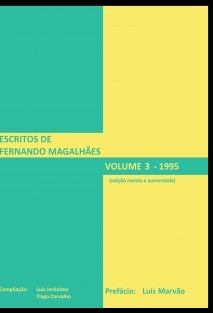O pós-rock e electro que ficou…
Fernando Magalhães
10 de Fevereiro 2003 Às 13:16
Do muito que passou, das bandas de pós-rock e da
electrónica não “erudita” que ouvi nos anos 90, eis aquilo que ficou e de que
continuo a gostar.
* são obras-primas, algumas delas não suficientemente
valorizadas quando escrevi as respectivas críticas (apenas o tempo e a
distância permitem a perspectiva mais correcta).
+ são discos fundamentais, dentro dos respectivos géneros
ou categorias musicais.
AMON
TOBIN – Supermodified (Ninja Tune, 2000)*
BERND
FRIEDMANN – Leisure Zones (Ash International, 1996)
B.
FLEISCHMANN – Pop Loops For
Breakfast (Charhizma, 1999) +
-
A Choir of Empty Beds (Fuzzy Box, 2000)
BIOSPHERE
– Cirque (Touch,
2000) *
-
Substrata 2 2XCD (Touch, 2001) +
-
Shenzhou (Touch, 2002)
BLECTUM
FROM BLECHDOM – The Messy Jesse Fiesta (Deluxe, 2000)
BLUTSIPHON
– Tammus (Gefriem, 1999)
CURD
DUCA – Elevator 3 (Mille Plateaux, 2000)
DAKOTA
OAK – Am Deister (Twisted Nerve, 2000)
DAT
POLITICS – Villiger (a-Musik, 2000) +
DYLAN
GROUP (THE) – More Adventures in Lying
Down… (Bubble Core, 1999)
-
Ur-Klang Search (Bubble Core, 2000)
EARDRUM
– Last Light (The Leaf, 1999)
EXPLODING
THUMBS – Flying Without Wings (Holistic, 1998)
EXPERIMENTAL
AUDIO RESEARCH – The Köner
Experiment (Mille Plateaux, 1997)
-
Millenium Music, A Meta-Musical Portrait (Atavistic, 1997)*
FAULTLINE
– Closer Colder (The Leaf, 1999)*
FENNESZ – Plus Forty Seven Degrees 56’ 37”
Minus Sixteen Degrees 51’ 08” (Touch, 1999) +
- Field
Recordings, 1995-2002 (Touch, 2002)
FENNESZ,
O’ROURKE, REHBERG – The Magic Sound of Fenn o’Berg (Mego, 1999)
FORT
LAUDERDALE – Time Is Of The Essence (Memphis Industries, 2001)
FRIDGE –
Ceefax (Output, 1997) +
- Eph (Go Beat, 1999)
FUXA – 3 Field Rotation (Ché, 1996) +
- Very Well Organized (Ché,
1996)
- Accretion (Mind Expansion,
1998)
F. X.
RANDOMIZ – Goflex (a-Musik, 1997)*
GAS
– Pop (Mille Plateaux, 2000) +
GASTR
DEL SOL – Upgrade &
Afterlife (Drag City, 1996) +
-
Camoufleur (Domino, 1998) +
GENERAL MAGIC – Rechenkönig (Mego, 2000)
GUSTAVO LAMAS –
Celeste (Traum, 1999)
- Plural (Fragil, 2000)
HOLGER
HILLER – As Is (Mute, 1991)
+
-
Holger Hiller (Mute, 2000)
HOLOSUD
– Fijnewas Afpompen (a-Musik, 1998)*
ILPO
VAISANEN – Asuma (Mego, 2001)
ISAN – Beautronics (Tugboat, 1998) +
- Salamander (Morr Music, 1999)
ISOTOPE
217 – The Unstable Molecule (Thrill
Jockey, 1997) +
- Utonian
Automatic (Thrill Jockey, 1999)
- Who Stole the I
Walkman? (Thrill Jockey, 2000)
JAN
JELINEK – Computer Soup (Audiosphere, 2002)
JESSAMINE
– Another Fictionalized History (Histrionic, 1997)
JIM
O’ROURKE – Bad Timing (Drag City, 1997)*
KLANKRIEG
– Radionik (Cling Film, 1999)
KONRAD
KRAFT – Alien Atmospheres (Elektro-Smog, 1996) +
KREIDLER
– Weekend (Kiff, 1996) +
- Appearance In
The Park (Kiff, 1998)*
LABRADFORD
– E Luxo So (Blast First, 2000)
L@N –
L@N (a-Musik, 1996)
MOUSE ON
MARS – Vulvaland (Too Pure, 1994)
-
Iaora Tahiti (Too Pure, 1995)*
-
Autoditacker (Too Pure, 1997)
-
Instrumentals – Sonig, 1998)
-
Niun Niggung (Rough Trade, 1999) +
-
Idiology (Sonig, 2001)
OCSID –
Opening Sweep (Ash International, 2001) +
OLIVIA
TREMOR CONTROL – Black Foliage, Animation Music. Volume One (Flydaddy Inc.
1999)
ORCHESTER
33 1/3 – Orchester 33 1/3 (Plag
Dich Nicht, 1997)*
-
Maschine Brennt (Charhizma, 1999)
PAN
SONIC – A (Blast First, 2000)*
- Aaltopiiri
(Blast First, 2000)
PETE
NAMLOOK – Namlook VI (Fax,
1994)
-
Syn 2XCD (Fax, 1994) +
-
Namlook XI (Fax, 1996)
PETE
NAMLOOK & CHARLES UZZELL EDWARDS – A New Consciousness 2 (Fax, 1994)
PETE
NAMLOOK & LUDWIG REHBERG – The Putney II (Fax, 1994)
PLURAMON
– Render Bandits (Mille Plateaux, 1998)
RADIAN –
Rec.Extern (Thrill Jockey, 2002)
RECHENZENTRUM
– Rechenzentrum (Kitty-Yo, 2000)
+
-
The John Peel Session (Kitty-Yo, 2001)
REZNICEK
– Stube (Odd Size, 1996) +
ROME –
Rome (Thrill Jockey, 1996)
SACK
& BLUMM – Sack & Blumm (Tom, 1999)*
SALARYMAN
– Salaryman (City Slang, 1996)
- Karoshi (City
Slang, 1999)
SATOR ROTAS – Sator Rotas (a-Musik, 1999)
SCHLAMMPEITZIGER
– Spacerokkmountainrutschquartier (a-Musik, 1997)*
SHABOTINSKI
– (B)ypass (K)ill (Charhizma, 1999)
SOUL
CENTER – Soul Center (W.v.B. Enterprises, 2000) +
SPRING
HEEL JACK - Oddities (Thirsty
Ear, 2000)
-
Disappeared (Thirsty Ear, 2000)
-
Masses (Thirsty Ear, 2001)
-
Amassed (Thirsty Ear, 2002)*
STARS OF
THE LID – Avec Laudenum (sub
Rosa, 1996)
-
Gravitational Pull vs. The Desire for an Aquatic Life (Kranky, 1997)
-
The Tired Sounds of Stars of the Lid 2xCD (Kranky, 2001)
STEREOLAB
– Emperor Tomato Ketchup (Elektra, 1996)
STEVE
FISK – 999 Levels of Undo (Sub Pop, 2001)
SUPERSILENT
– Supersilent 4 (Rune Grammofon, 1998)
TELE.FUNKEN
– A Collection of Ice-Cream Vans Vol. 2 (Domino, 2000) +
THOMAS
BRINKMANN – Rosa (Max Ernst, 2000) +
THOMAS
KONER – Nunatak Gongamur (Barooni, 1990)
TIED +
TICKLED TRIO – EA1 EA2 (Payola, 1999) +
TONE REC
- Pholcus (Sub Rosa, 1998)*
- Coucy-Pack (Sub
Rosa, 1999)
TO
ROCOCO ROT - CD (Kitty-Yo,
1996) +
-
Veiculo (City Slang, 1997)*
-
The Amateur View (City Slang, 1999)*
TO
ROCOCO ROT & I-SOUND – Music is a Hungry Ghost (City Slang, 2001) +
TORTOISE - A Digest Compendium of the
Tortoise’s World (Thrill Jockey, 1994/95) +
- Millions Now
Living Will Never Die (City Slang, 1996)*
- TNT (City
Slang, 1998)
- Standards
(Thrill Jockey, 2000)
TRANS
AM -
Surrender to the Night (City Slang, 1997) +
- Futureworld
(Thrill Jockey, 1999)
- Red Line
(Thrill Jockey, 2000)
UI – Lifelike (Southern,
1998)*
- The Iron Apple
(Southern, 1999)
USER
(THE) – Symphony #1 for Dot Matrix Printers (Staalplaat, 1999) +
VAINIO,
VAISANEN, VEGA – Endless (Blast First, 1998)
VERT –The Köln Konzert (Sonig, 2000)
- Nine Types of Ambiguity
(Sonig, 2001)
WORKSHOP
- Welcome back the Workshop (Captain
Trip, 1990)
- Talent (L’Age
d’Or, 1995)



















_Bubok.jpg)




















